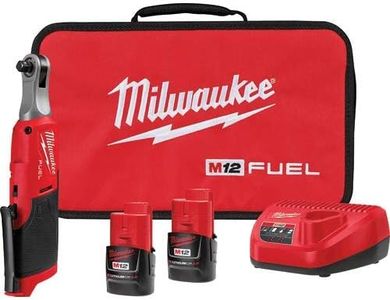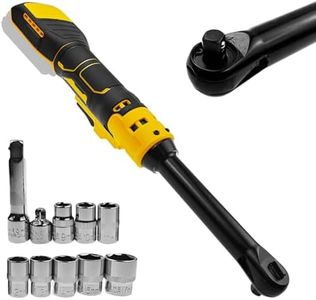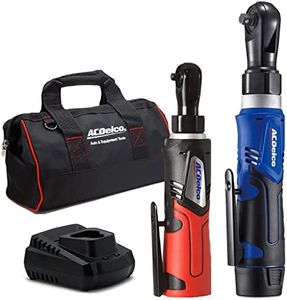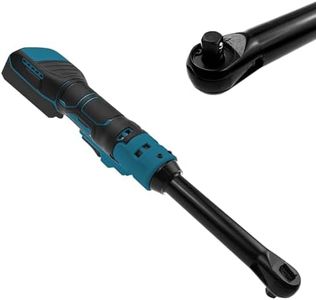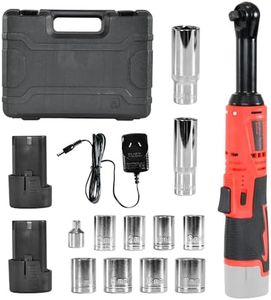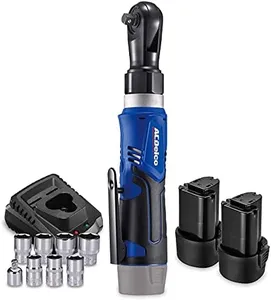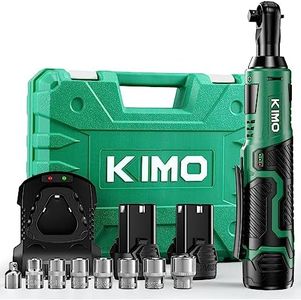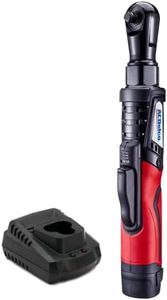We Use CookiesWe use cookies to enhance the security, performance,
functionality and for analytical and promotional activities. By continuing to browse this site you
are agreeing to our privacy policy
10 Best Cordless Ratchet Wrench
From leading brands and best sellers available on the web.Buying Guide for the Best Cordless Ratchet Wrench
Choosing a cordless ratchet wrench can make repair and assembly jobs much easier and faster, especially when working in tight spaces or places without access to power outlets. To get the best value and utility, it's important to understand the key features so you can choose a tool that matches your workload, working environment, and how often you plan to use it.Voltage (Battery Power)Voltage refers to the power level supplied by the battery. Higher voltage typically means the tool can deliver more torque, making it better suited for tougher tasks. Ratchet wrenches usually come in lower voltage (around 12V) for light tasks, mid-range (14V–18V) for general use, and higher voltage (20V+) for heavy-duty applications. If you mainly handle car repairs or small assembly jobs, a lower or mid-range voltage is usually sufficient, while high-volume or high-resistance bolts may need more power.
TorqueTorque is the turning force the wrench can apply, measured in foot-pounds (ft-lbs) or Newton meters (Nm). Light tasks, like electronics or light machinery, need lower torque, while automotive work or stubborn bolts require higher torque. Cordless ratchets typically range from about 30 ft-lbs to over 70 ft-lbs. Consider what types of jobs you'll do most often: if you're just tightening or removing smaller bolts, lower torque is fine, but for automotive or heavier work, higher torque is better.
Speed (RPM)Speed is measured in revolutions per minute (RPM) and shows how fast the wrench head spins. Lower speeds allow for more control and precision, while higher speeds are faster for routine tasks. Ratchets might offer speeds from 200 RPM to over 300 RPM. If you do delicate work, a lower (or variable) speed is preferable; for repetitive or less sensitive jobs, higher speeds help you finish faster.
Head Size (Drive Size)The head or drive size refers to the size of socket the ratchet can accept, commonly 1/4-inch, 3/8-inch, or 1/2-inch. Smaller sizes (1/4-inch) are ideal for tight spaces or lighter tasks, while 1/2-inch drives fit larger sockets for big bolts. Most general-purpose work uses 3/8-inch. Choose the size based on the most common bolts you encounter in your projects.
Battery Life and Charging TimeThis involves how long the wrench can run on a single charge and how quickly it recharges. Longer-lasting batteries reduce interruptions, especially helpful for extended jobs. Some tools have fast-charging features. If you often work for long periods or on-the-go, prioritize long battery life and quick charging; for shorter, occasional jobs, standard batteries are typically enough.
Weight and ErgonomicsWeight and ergonomics influence how comfortable and easy the wrench is to use, especially over long sessions. Lighter tools are less tiring and better for overhead or awkward angles, while bulkier models may have more power or durability. Think about how often you'll use the wrench, the positions you'll be working in, and choose a model that feels balanced and comfortable in your hand.
Built-in LightingSome cordless ratchets offer built-in LED lighting to help you see better in low-light areas or cramped spaces. If you often work in engine bays, under cars, or poorly lit areas, this feature can be quite helpful. If not, it's a nice addition but not essential.
